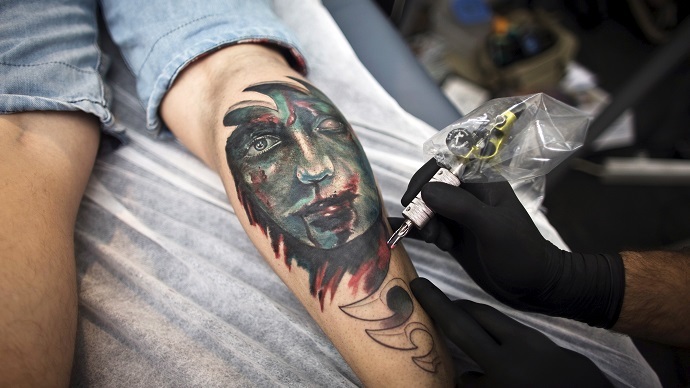Tell-tale tattoo: US govt researching biometric ink recognition

Tattoos might be the next biometric frontier, with one in five Americans sporting ink these days. The FBI is partnering with academia and private firms to develop a computer program that could help police identify people based on their body ink.
Matching tattoos with the government database could help officials identify victims of natural disasters, such as earthquakes or tsunamis. However, the government’s primary interest is they believe matching the tattoos into a computer system, could help to catch more criminals, as they have more body ink than the general population, according to computer scientist Mei Ngan.
Ngan works at the National Institute for Standards and Technology (NIST), a branch of the Department of Commerce that teamed up with the FBI to organize a “challenge” workshop. This gave an opportunity to universities and corporations to show off the results of their research into tattoo-matching technology.
Got ink? Tattoo algorithms could soon help identify criminals: http://t.co/QCp7Khiq6cpic.twitter.com/CATFoqyDO7
— Nextgov (@Nextgov) June 11, 2015
“You can't use it as a primary biometric like a finger print or face because it’s not necessarily uniquely identifying,” Ngan told the Washington Post. “But it can really help in cold cases where you don't have those things.”
READ MORE: UK police trained to detect ‘pedophile signs’ in tattoos and clothing
Alvaro Bedoya, of the Center on Privacy & Technology at Georgetown Law School, told the Post that identifying people on the basis of tattoos is less controversial than facial recognition or motion analysis, but that technology may be outpacing the law.
“People are being identified remotely without their knowledge,” Bedoya said, “and right now the Fourth Amendment doesn’t really say anything about that.”
The workshop was organized by the NIST at the agency’s headquarters in Gaithersburg, Maryland, and sponsored by the FBI’s Biometric Center of Excellence. Participants tested their image-recognition software in five different scenarios, such as basic tattoo detection, identification over time, and matching a partial image of a tattoo to a complete photo.
Each team was given the same set of images, drawn from the FBI’s existing Next Generation Identification database that includes tattoos in addition to fingerprints and facial recognition. Currently, the database relies on written description of the tattoos, which can be vague and sometimes not particularly helpful, says Ngan.
NIST Workshop Considers Ways to Improve #Tattoo Recognition http://t.co/8rbzC6dXFYpic.twitter.com/2rqWZETyGx
— NIST (@usnistgov) June 8, 2015
Some of the systems had “hit rates well above 90 percent" in certain tests, like matching a partial photo of the tattoo to the whole thing. Two areas that needed further research, Ngan said, were distinguishing similar tattoos on different people, and recognizing a tattoo from a sketch or a drawing, rather than a photo.
“Improving the quality of tattoo images during collection is another area that may also improve recognition accuracy,” Ngan said.
Participants in the NIST workshop included the imaging company Compass Technical Consulting, the Fraunhofer Institute of Optronics, System Technologies and Image Exploitation, the French Alternative Energies and Atomic Energy Commission, the nonprofit research organization MITRE, the biometric tracking technology firm MorphoTrak, and Purdue University.
Founded in 1901, the NIST is one of the oldest US government science laboratories. It has been at the forefront of biometric research for decades, conducting mass evaluations of fingerprint and face recognition systems.











